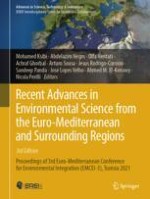2024 | OriginalPaper | Buchkapitel
Preliminary Evaluation of Quinoa Genotypes Introduced in the Saharan Zone of Algeria, Case of Ouargla
verfasst von : Kelthoum Maamri, Ouiza Djerroudi-Zidane, Ahmed Chaabena, Didier Bazile
Erschienen in: Recent Advances in Environmental Science from the Euro-Mediterranean and Surrounding Regions (3rd Edition)
Verlag: Springer Nature Switzerland
Aktivieren Sie unsere intelligente Suche, um passende Fachinhalte oder Patente zu finden.
Wählen Sie Textabschnitte aus um mit Künstlicher Intelligenz passenden Patente zu finden. powered by
Markieren Sie Textabschnitte, um KI-gestützt weitere passende Inhalte zu finden. powered by
